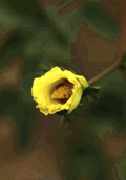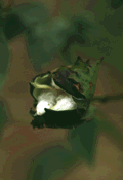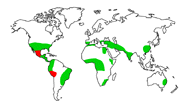Cotton (Gossypium)
Mallow family
(Malvaceae)

| 
| 
|
| Cotton plant
| Flower
| Bursting boll with seed
fibres
|
Source: Bock D., MPI Köln
Distribution, Yield, Use:
- Distribution:
Cultivation in warm arid climates.
The most important countries for production are China,
USA, USSR, India, Pakistan, Turkey and Egypt.
Requires deep soil, relatively
salt resistant.
- Yield:
10 - 40 dt/ha
comprising ca. 35% fibre,
65% seeds
- Use:
- Seed fibres (lint)
for clothing
- Seed oil
for cooking oil, technical uses
- pressing residues
as animal feed
Seeds contain 15 - 25% oil with high
linoleic acid content,
15 - 35% protein

Region of origin: Region of cultivation:
Region of cultivation: 
- Cultivation and Breeding:
The origins of cotton are thought to lie in the African - Asian area and on the West coast of America. The original short fibred type has, over the course of approximately 4000 years of domestication, been selected to produce the domesticated strain, the fibre quality and length of which greatly surpasses that of the original form.
The two most commercially important tetraploid strains, G. hirsutum (Upland cotton) and G. vitifolium (Sea Island cotton), which have 2 - 4 cm long seed fibres, have been developed in mid and South America from the diploid African - Asiatic and American wild types.
- Breeding aims:
Increasing fibre production, early ripening, mechanical harvesting and improvements in resistance to diseases and pests are the most important breeding aims.
Length, fineness and elasticity of the fibres play an important role with respect to quality.
Additionally, increasing the oil content and reducing the content of gossypol (a poisonous polyphenol found in the seeds) are of interest.
Text by
Dr. Wolfgang Schuchert
Adapted to HTML by R.Saedler




 Region of cultivation:
Region of cultivation: 